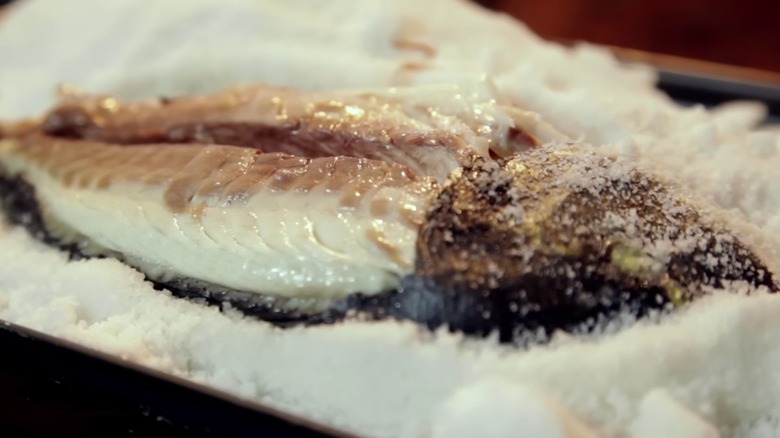Gordon Ramsay's Essential Tip For Salt-Crusted Fish
It takes a special kind of person to sign up to compete in one of Gordon Ramsay's reality television cooking competitions. One might call them a masochist if you've witnessed the chef's string of profanities, short fuse, and fiery temper directed at contestants on "Hell's Kitchen." Most of Ramsay's 'mentoring' on the show can't be shared without redacting the four-letter word comments he hurls at chefs, though there are rare compliments. Fans know some chef mistakes are sure to set him off, like talking back, poor communication in the kitchen, and serving raw food.
Holding seven Michelin stars, Ramsay is plenty qualified to command his kitchens. Since 1998, when the chef opened his first restaurant, "Restaurant Gordon Ramsay," which earned an impressive three Michelin stars, he has set high standards for fine dining in London and continues to do so, being one of only four chefs in the U.K. to hold such a designation, per his official website. The food personality's massive brand is now represented globally with different restaurant concepts from the U.S. to Singapore.
If you can't dine out at one of his eateries, Ramsay offers hands-on cooking classes at his Academy or an online MasterClass series taught by chefs who assumingly have his approval. But if you'd like to learn from him directly, Ramsay's cooking shows can be found on YouTube, where the chef demystifies intimidating-looking dishes like salt-crusted fish that are straightforward, according to him.
How to salt-crust fish? Coverage is key
Join the almost 200,000 YouTube viewers who have watched Ramsay prepare salt-crusted sea bream using an old-school method to achieve a moist fillet with a showstopping presentation. Salt is mixed with water to create a texture similar to a packed snowball. The packed salt creates a kiln, trapping moisture while it gently steams the fish, eliminating one of the most common mistakes when preparing fish — drying it out.
Ramsay begins by seasoning the fish with lemon, salt, and fennel seeds, and notes that keeping the scales and skin on the fish is critical to protect the flesh from getting salty. This recipe uses an enormous amount of salt, so Ramsay advises saving the expensive stuff for another dish as he packs wet salt all over the fish, covering every inch as any uncovered areas could dry out.
The fish is baked in a 350-degree oven until it registers 125 degrees, about 25 minutes per pound. After allowing the fish to rest, MasterClass advises home cooks to gently crack and remove the top salt crust, careful not to cut into the fish. The last step involves brushing residual salt off the fish, then removing the skin before serving.
This salt-crusted technique works well for most whole fish, but also root vegetables like beets that benefit from removing the skin after cooking. Ramsay discourages using this technique with oily fish. It's also suitable for pricy cuts of meat where you want to avoid overcooking, like beef tenderloin.

